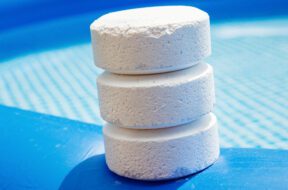
Want to learn more about algaecide? Read on to find out when to add algaecide to your pool maintenance routine and other helpful tips.
Taking care of your pool often costs thousands of dollars of pool maintenance each year if you rely solely on professionals and appointments. There is an easy way to combat these costs, however. By taking the steps to clean the and maintain the pool and water yourself you can save a lot of extra money for your wallet.
How much does pool maintenance cost? The thought of having a pool to take a dip in is a thought we all fall in love with. Especially in warm climate areas, a pool is a must in order to stay cool and enjoy the summer sun. This luxury is not without its share of headaches, though. One of these is that there are hefty costs associated not only with the planning and building of said pool, but also with the overall cleaning, maintenance, and upkeep of a pool. As reported by Home Advisor, the average price for a one-time cleaning of a residential pool is $233.
This all adds up to the fact as a pool owner you can expect to spend between $1200 and $1800 per year in basic upkeep and could spend anywhere up to $5,000 to keep it in a good and clean condition. These costs are associated with service packages that include the following:
in places with cold winter months, closing down your pool for winterization (see article on When to Close your Swimming Pool) employs a cost of $150 to $300. The re-opening of the pool also costing around that same rate. This means that while there are averages to base your future rates upon, the cost of upkeep on a pool largely depends on your location. This often relates to need (or lack of need) for constant maintenance. For instance, when comparing the average cost per month of pool upkeep on Home Advisor, the average in Portland, Oregon is listed at $255 per month, as opposed to Jacksonville, Florida’s rate of $172 per month.
This discrepancy in price is likely due to the typical climate and potential dirtying the pool. This has a large impact on what it will take for your pool to stay in good shape. For example, in a colder place like Portland there are costs for winterization and re-opening. There are also a large number of plants and other debris that dirty your pool, and also heightened costs for heating associated with the generally cold climate. (See article on “Cost to Heat a Pool”) This can be contrasted when compared to a place like Florida, where there are still plenty of plants and animals to deal with, but there is a higher climate and “self-heating process”, along with a lower potential winterization period that cut down on the costs for the total package.
Article on how to winterize your pool here
While the costs of keeping a pool running may be tough to swallow, there are things you may do yourself to minimize the damage to your wallet. The most important of these is cleaning the pool yourself. While this may seem self-explanatory, there are many levels to the upkeep of a pool. Some of these responsibilities are the following:
The cleaning of your water itself through chemical treatment is another way to minimize costs. You can keep your pool healthy and clean by using our Pool Calculator application via our website or mobile app. Along with a water testing strips, you can determine the treatments necessary for your pool. From this point you could have professional treat the water. OR, you could save even more money and carry out the treatment yourself. This self-treating will cut down on the appointments you need by a heavy margin and allow yourself to be more self-sufficient in regard to your pool’s health and to your bank account.
Try out our Pool Calculator as you clean and maintain your pool! For more information on how to care for your swimming pool, see our blogs on Pool Maintenance

Want to learn more about algaecide? Read on to find out when to add algaecide to your pool maintenance routine and other helpful tips.

In this quick guide, we’ll answer the question “can you over shock a pool” and unveil the factors to consider when shocking a pool.

Maintaining both pH and total alkalinity in your swimming pool is important for keeping your pool properly sanitized and non-corrosive. Total alkalinity is to pH what cyanuric acid is to free chlorine. Total alkalinity stabilizes pH levels. The ideal pool pH level is 7.4 to 7.6. The ideal total alkalinity level is 80 to 120 ppm.

The Association of Pool and Spa Professionals recommends free chlorine levels for both swimming pools and hot tubs be kept between 2.0 and 4.0 ppm. However, the Center for Disease Control recommends free chlorine stay above 1 ppm in pools and 3 ppm in hot tubs.